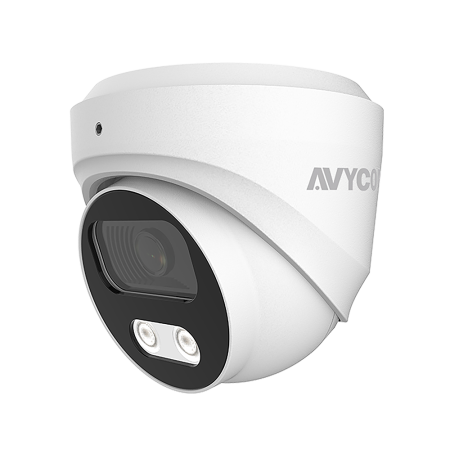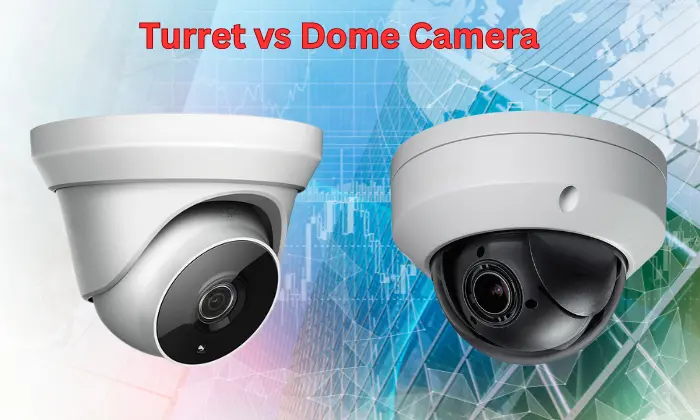When choosing security cameras, two popular types of cameras are dome cameras and turret cameras. You can use both cameras in CCTV (closed-circuit television) or IP (Internet Protocol) video surveillance systems. However, they serve different purposes based on your security needs. To help you make an informed decision, let’s break down the advantages and disadvantages of each.
What Is a Turret Camera?

Turret cameras, on the other hand, are known for their ball-and-socket design. This means the camera lens can be easily adjusted and aimed in different directions. They don’t have a dome covering, which makes them less resistant to vandalism compared to dome cameras. However, this lack of a dome gives turret cameras an advantage when it comes to night vision. Since there’s no dome to cause glare, turret cameras tend to offer clearer night footage.
Once installed, turret cameras can be conveniently swiveled to recalibrate monitoring and field of view, making them simpler to modify. If you need to change the angle of the camera after installation, turret cameras make that process simple without requiring any special tools. Additionally, turret cameras often come with optical zoom, allowing them to capture clear footage from both near and far.
What Is a Dome Camera?

Dome security cameras get their name from their dome-shaped design. The design houses the camera lens inside a transparent, protective dome. This design helps the camera blend into its surroundings, making it less noticeable in places like stores, offices, or homes. Dome cameras are especially good at offering wide-angle views, which means they can capture large areas like parking lots or big rooms.
One of the biggest advantages of a dome camera is its resistance to vandalism. Since the camera is housed inside a protective dome, it’s harder for someone to tamper with it. This makes it a good option for areas where vandalism might be a concern.
However, dome cameras also have some limitations. For instance, they are not always the best choice for capturing detailed images of faraway objects. The dome itself can also cause issues with night vision. When infrared (IR) lights are used, glare from the dome’s surface can bounce back, reducing the quality of the night footage.
Turret vs Dome: Which Is Better for Night Vision?
When it comes to night vision, turret cameras are typically the better option. Dome cameras can suffer from IR bounceback, where the dome causes the infrared lights to reflect back into the camera lens. This can distort the footage and make it harder to see at night. In contrast, turret cameras don’t have this problem because their lenses are exposed, providing a clearer night view. If you need strong night vision, especially in low-light conditions, turret cameras are the way to go.
Turret vs Dome: Which Offers Clearer Images from a Distance?
For long-range clarity, turret cameras tend to outperform dome cameras. While dome cameras excel in capturing wide viewing angles, they don’t always provide the same level of detail when viewing objects far away. Turret cameras, with their adjustable lenses and zoom capabilities, can give you a sharper view of distant objects, making them ideal for situations where you need to capture faces or license plates from a distance.
Turret vs Dome: Which Is Better for Outdoor Use?
Both dome and turret cameras can be used outdoors, but dome cameras have a slight edge due to their compact design. The dome helps protect the internal components from dust, rain, and other elements. Additionally, dome cameras are less likely to attract birds or gather spiderwebs, which can sometimes be a problem with turret cameras.
However, dome cameras do have a downside when installed outdoors. If moisture or condensation collects inside the dome, it can blur the footage. For this reason, it’s important to install dome cameras under a cover, such as an eave or overhang, to protect them from water damage.
When choosing a camera for outdoor use, also consider the IP (Ingress Protection) rating. This rating indicates how well the camera is protected against dust and water. For outdoor cameras, a higher IP rating (like IP68) is recommended to ensure weather resistance.
Turret vs Dome: Which Is More Resistant to Vandalism?
If vandalism is a concern in your area, dome cameras are generally a better choice. The dome housing protects the lens from being easily tampered with or damaged. Many dome camera models also come with a vandal-resistant rating (IK10), which means they can withstand significant physical impact. This makes them a good option for areas like parking lots, public spaces, or any place prone to vandalism.
Dome vs. Turret: Which Is More Discreet?
If you want your security cameras to be as discreet as possible, dome cameras are the better option. Their compact design allows them to blend in more easily with their surroundings, making them less noticeable. This can be important in places like retail stores, restaurants, or offices where you don’t want customers to feel uncomfortable with obvious surveillance.
Turret cameras, on the other hand, are more visible and are often used in places where you want people to know they’re being watched. Their prominent design can serve as a deterrent to potential criminals, making them a good choice for businesses where theft or shoplifting is a concern.
Dome vs. Turret: Which Should You Choose?

When deciding between a dome or turret camera, think about your specific needs:
Night Vision: If night vision is crucial, turret cameras are the better option because they avoid issues with glare.
Vandal Resistance: If you’re worried about vandalism, dome cameras offer better protection with their vandal-resistant design.
Outdoor Use: Both cameras can work outdoors, but dome cameras need extra protection against moisture. Always check the IP rating for outdoor installations.
Discretion: Dome cameras are more discreet and blend into their surroundings, making them suitable for places where subtlety is important.
Long-Range Clarity: If you need to capture detailed footage from a distance, turret cameras offer better zoom and clarity.
Turret vs Dome Cameras – Making the Right Choice
Both turret and dome cameras have their own set of strengths and weaknesses, making them suitable for different scenarios. Turret cameras are ideal for environments where night vision, optical zoom, and ease of adjustment are priorities. On the other hand, dome cameras excel in providing wide-angle coverage, vandal resistance, and discretion.
Think about your surveillance area to select the camera type that fits your needs best. You can find a camera with great night vision. It can also be vandal-proof. Additionally, it can blend in with your surroundings. These features will keep your property safe.
Contact a security expert for residential and commercial security needs and help with turret or dome cameras. They can help you choose the best camera for your needs. They can also make sure to place the camera correctly for maximum effectiveness.








